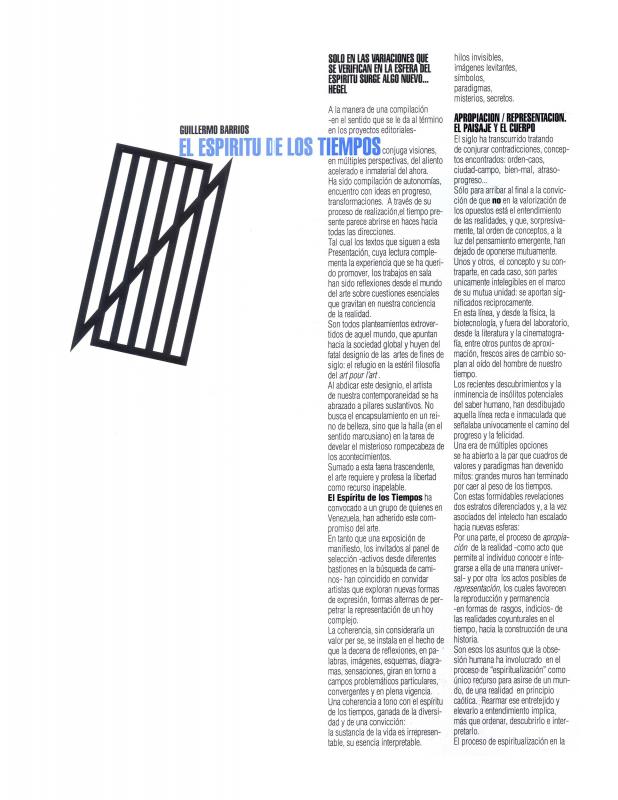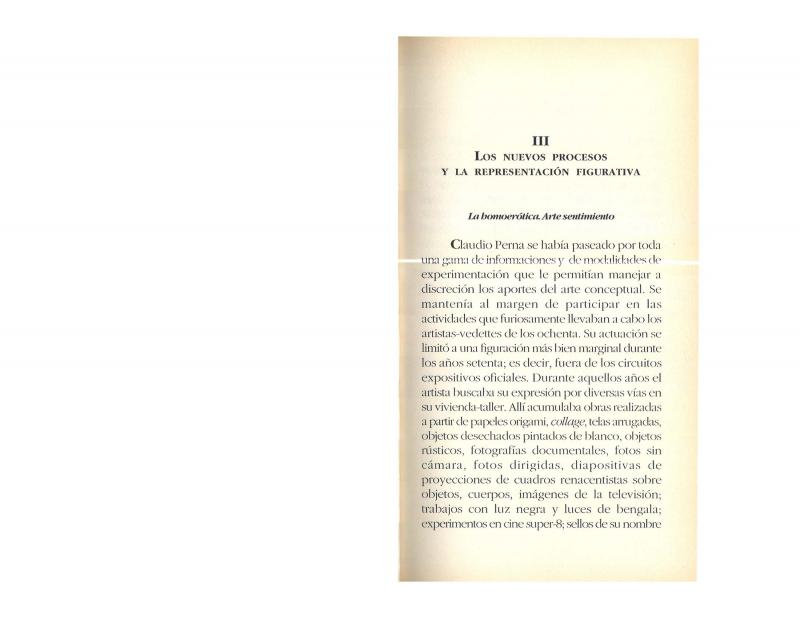El espíritu de los tiempos—the exhibition organized by the Ateneo de Caracas to celebrate its 60th anniversary—assembled a representative sample of the conceptual and neo-conceptual work being produced in Venezuela in the 1990s. Under the curatorial baton of Guillermo Barrios, five well-known curators and critics were invited to choose an artist and write an essay. The catalogue included an introductory essay by Barrios, “El espíritu de los tiempos” [doc. no. 1160984] and this essay by Zuleiva Vivas (b. 1951), “Las opciones del tiempo para el nuevo espíritu” about Claudio Perna (1938–97). It also included essays by Graciela Pantin, “Reflexiones en torno a la contemporaneidad en las artes visuales venezolanas. ‘4 minutos para mirar’ una obra de Susana Amundaraín y Xiomara Moreno” [doc. no. 1222405], María Elena Ramos, “El espíritu de los tiempos. Y por qué José Antonio Hernández-Diez” [doc. no. 1065692], and Ariel Jiménez (about José Gabriel Fernández), “El espíritu de los tiempos” [doc. no. 1097294]. The other guest, Miguel Miguel selected the artist Alfred Wenemoser, but declined to submit an essay.
Zuleiva Vivas, the curator and contemporary art critic, has spent much of her career studying the Italian-Venezuelan conceptual artist’s life and work. In her essay, Vivas provides a review of the works Perna showed at the exhibition, as well as important details about the languages, genres, and techniques he explored in his considerable, eclectic intellectual and material legacy, which included photography (documentary, conceptual, anonymous); geography; painting; physical activities; social sculpture; participatory art; letters; accu-painting; self-copies; the creation of the Centro de Arte y Ecología (RADAR); cartography; writing; films; videos; drawing; graphic arts; collage; instant reproduction devices (Polaroids and photocopies); in short, an exploration of the self. His body of work is therefore hard to classify. He divided it into three main humanist categories: Thought-Art, Feeling-Art, and Social-Art.
After his death in 1997 Vivas and a group of his close friends created the Fundación Claudio Perna, an organization devoted to the study and exposure of his intellectual legacy and his vast body of work. Based on her thesis about that body of work, Vivas wrote a book, La desaparición de los límites. Claudio Perna: aportes para el estudio del arte latinoamericano actual (Caracas: Fundación Claudio Perna, 2000). Vivas was the promoter and curator of the first major retrospective of Perna’s work in August 2004 at the Galería de Arte Nacional de Caracas: Arte Social. Claudio Perna.
To read other articles about this artist, see by Margarita D’Amico “1: Hoy es arte lo que no era” [doc. no. 1068360]; by Luis Enrique Pérez-Oramas “El autocurrículum de Claudio Perna, escultura social y novela hiperrealista” [doc. no. 1161917]; by Roberto Guevara “Claudio Perna o cómo ser libre en la marginalidad” [doc. no. 1080814]; by Elsa Flores “(Sin título) [Vivir quiere decir dejar huellas…]” [doc. no. 1063156]; by María Elena Ramos “Arte–idea–geografía” [doc. no. 1080766]; by José Napoleón Oropeza “Claudio Perna. Disfruto el estilo de no tener estilo” [doc. no. 1067382]; and, by Lourdes Blanco “Claudio Perna: fotocopias” [doc. no. 1080715]. See also the following articles by Zuleiva Vivas: “Visión panorámica de las nuevas cartografías” [doc. no. 1157158]; “Los nuevos procesos y la representación figurativa” [doc. no. 1157174]; “Intervención creativa en el contexto social” [doc. no. 1161969]; and “Claudio Perna y el arte del pensamiento” [doc. no. 1163950].















